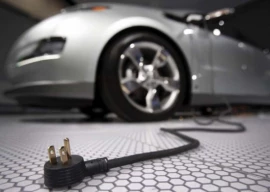
With Punjab Energy Minister Sher Ali Khan in the chair, it was announced that the 50-megawatt (MW) Quaid-e-Azam Solar Park in Cholistan will start contributing to the national grid within six months, under the first phase.

The conference was arranged by Faculty of Agricultural Engineering and Technology, University of Agriculture Faisalabad (UAF) in collaboration with University of Kassel, Germany, US Department of Agriculture (USDA) and International Centre for Development and Decent Work (ICDD). The moot aimed to highlight the potential of renewable energy to help cater the energy demand in the country.
Speaking on the occasion, the minister said that the Punjab government was taking all possible steps to address the prevailing energy crisis. Promotion of alternative energy was also part of the strategy mapped out by the government to control the power crisis.
Pakistan having an installed capacity of 23,000MW, only produces 16,000MW – low capacity utilisation. The Punjab energy minister went on to say that the provincial government was setting up various small dams on canals with a capacity of 10-20MW each. Moreover, the 120-MW Taunsa Barrage will also become online soon, he added.
The province was also trying to produce power from biomass. Sugar mills in the province were being encouraged to generate power from sugarcane waste (bagasse) and supply to the national grid.
During the moot, UAF Dean Professor Dr Muhammad Iqbal also called for promoting renewable sources of energy, saying that Pakistan could potentially produce 20,000MW by utilising wind sources.
Professor Dr Oliver Hensel, from University of Kassel, Germany, said, “Pakistan is blessed with the seasons where sun shines throughout the year. Local farmers should take advantage of renewable energy sources like solar.”
German Academic Exchange Services (DAAD) Project Coordinator Pakistan Dr Anjum Munir said in present times, it was the need of the hour for Pakistan to shift to alternative energy considering acute shortage of fossil fuel in the country.
Published in The Express Tribune, October 2nd, 2013.
Like Business on Facebook, follow @TribuneBiz on Twitter to stay informed and join in the conversation.
COMMENTS (4)
Comments are moderated and generally will be posted if they are on-topic and not abusive.
For more information, please see our Comments FAQ



1725612926-0/Tribune-Pic-(8)1725612926-0-165x106.webp)













Solar gives you peak efficiency at 2PM. The peak efficiency is 40-60% of any solar product. So if they install a 100 MW project you get 50MW. That too in the day. Wind is much much better, plus the investors in Wind are mostly private, 2000MW of private investment is just standing there for the Govt to give them a go ahead. But its being overlooked. Wonder why.
A viable alternative for Pakistan - one that can be produced locally as the technology is well known and Pakistan should be able to compete with China as your labor rates are competitive. The key is to produce the panels in Pakistan - will provide energy, employment, and possible export alternatives.
reduce their prices and bring mfr tech in Pakistan
I do not agree that Solar Energy is the way to go, with great respect to the foreign professors and intellectuals, we at Pakistan must understand that solar energy is promoted by the 'Green Party' in Western Countries as an alternative form of energy. No western country is foolish enough to rely on Solar or Wind Energy in its entirety and that should not be the case in Pakistan either. . I know our bureaucrats' mouths will be watering at the prospect of earning millions of dollars through commission on importing solar panels. but the fact remains that fossil fuels are not in short supply in Pakistan, we have an abundance of them. Solar and Wind energy cannot bypass nepotism, corruption, and inefficiencies in our existing power generation infrastructure. These need to be addressed first before we can even think of the Rich Man's solution of Solar and Wind. . All developed countries, including India and China rely on fossil fuel and water powered generation to develop, sustain and maintain their base power, and only use solar and wind for gap filling. We should first develop cheap and efficient base power using coal and water, then think about solar and wind if appropriate.